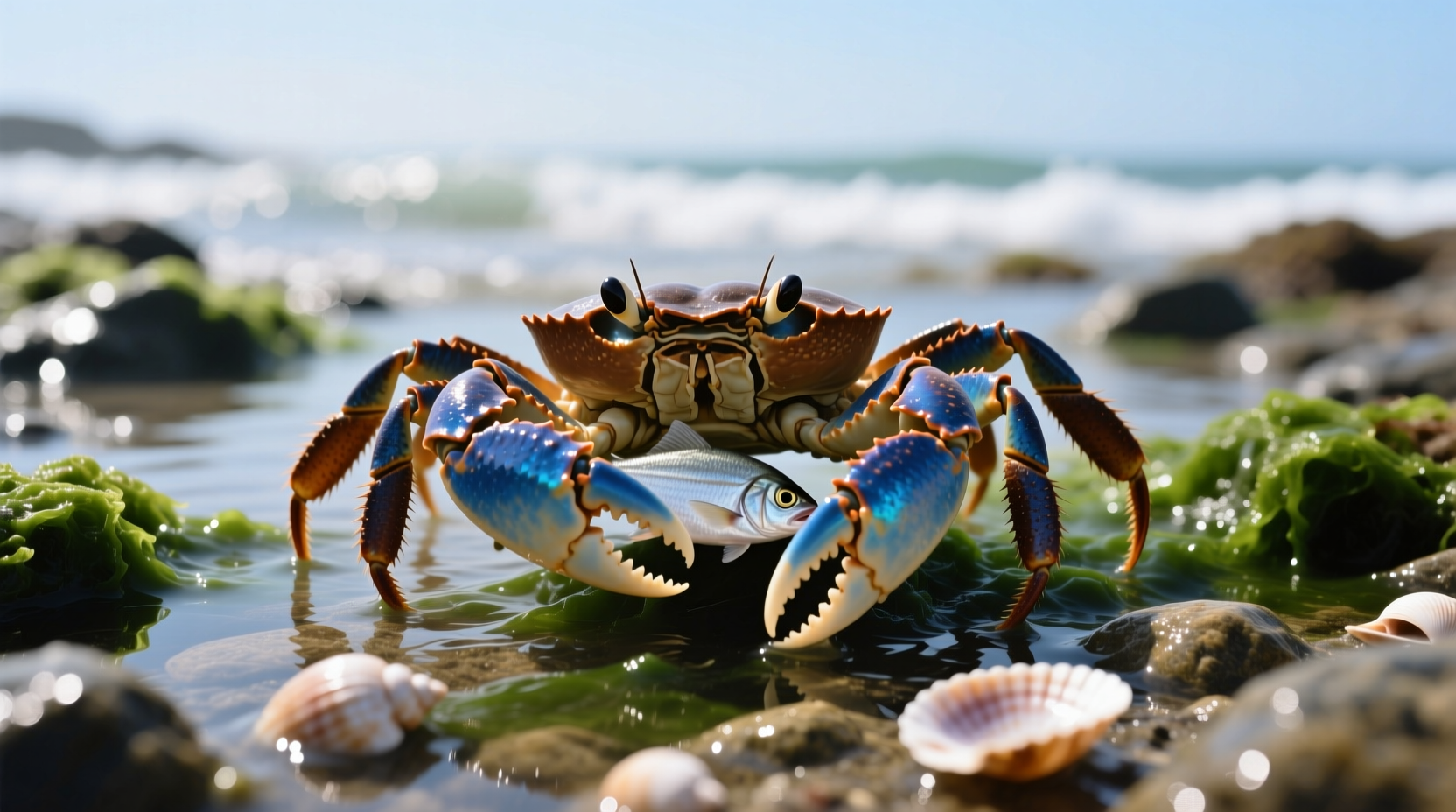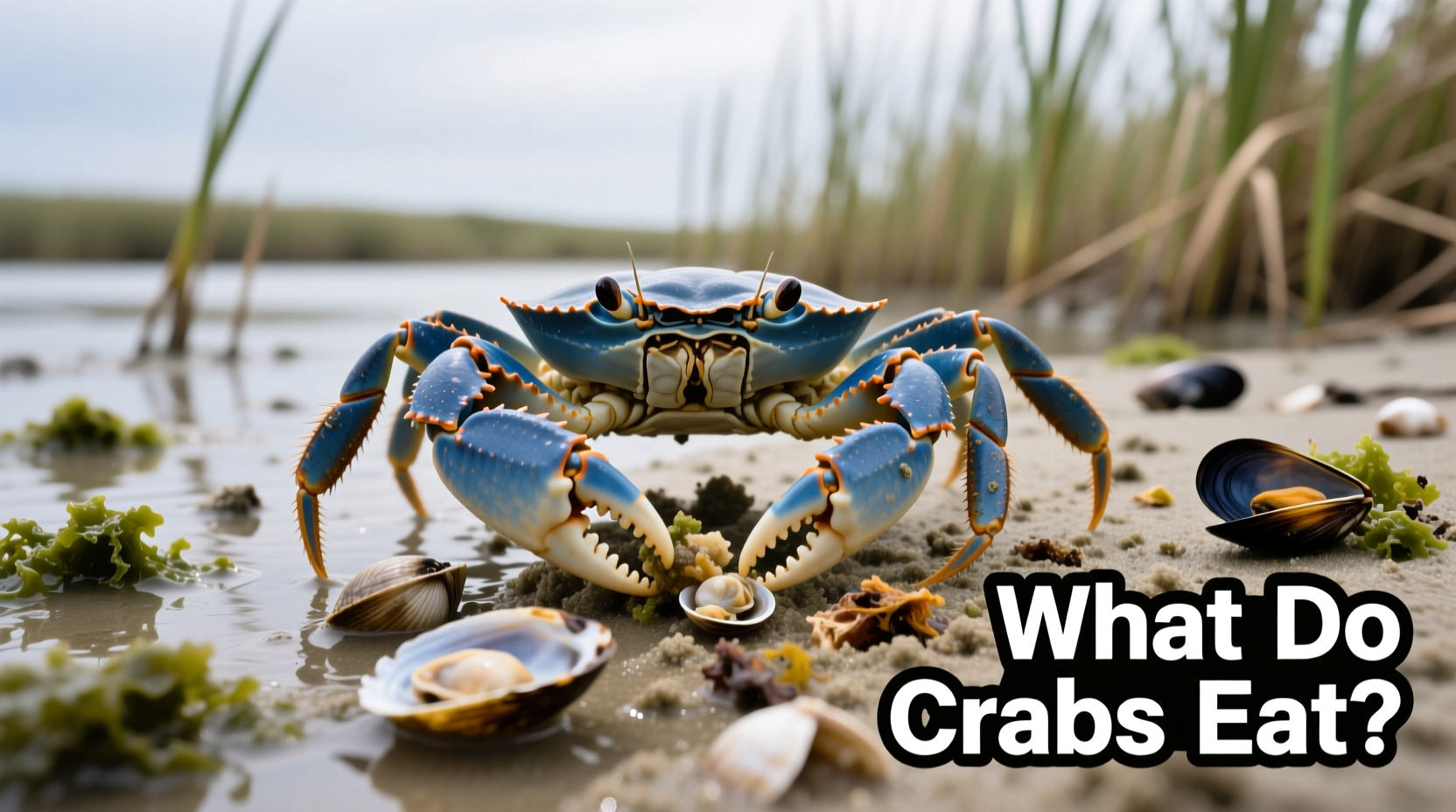Understanding what crabs eat isn't just fascinating marine biology—it's essential knowledge whether you're maintaining a home aquarium, studying coastal ecosystems, or simply curious about these resilient crustaceans. This comprehensive guide reveals exactly what different crab species consume in the wild and in captivity, with practical feeding advice you can apply immediately.
Crab Feeding Fundamentals: Nature's Opportunistic Eaters
Crabs operate as nature's cleanup crew with highly adaptable diets. Unlike specialized predators, crabs evolved as opportunistic omnivores, consuming whatever nutritional sources they encounter. Their unique feeding anatomy—including powerful claws for crushing and smaller mouthparts called maxillipeds for manipulating food—enables them to process diverse food types.
"Crabs represent one of evolution's most successful dietary generalists," explains Dr. Robert Elwood, crustacean behavior researcher at Queen's University Belfast. "Their ability to switch between plant and animal matter based on availability has allowed them to colonize nearly every aquatic and semi-aquatic environment on Earth."

Wild Crab Diets Across Different Habitats
Crab feeding behaviors change dramatically based on their environment. Understanding these variations helps explain why "what food does crabs eat" requires nuanced answers.
| Habitat Type | Primary Food Sources | Feeding Behavior |
|---|---|---|
| Ocean Floor (e.g., Dungeness crab) | Clams, mussels, small fish, dead organisms | Active hunting using claws to crack shells |
| Intertidal Zones (e.g., Fiddler crab) | Algae, detritus, microorganisms | Filter-feeding sediment through specialized mouthparts |
| Freshwater (e.g., Thai Devil Crab) | Aquatic plants, insects, small fish | Opportunistic scavenging with plant preference |
| Land (e.g., Coconut crab) | Fruit, nuts, carrion, other crabs | Nocturnal foraging with powerful crushing claws |
Feeding Pet Crabs: Avoiding Common Mistakes
Many enthusiasts underestimate the nutritional complexity required for captive crabs. Proper feeding prevents health issues and extends lifespan.
Hermit Crab Dietary Requirements
Contrary to popular belief, hermit crabs need more than just commercial pellets. The U.S. Fish & Wildlife Service recommends:
- Calcium sources: Cuttlebone, crushed eggshells (essential for shell development)
- Protein: Occasional cooked shrimp or fish (2-3 times weekly)
- Fruits and vegetables: Kale, apple, mango (providing hydration and vitamins)
- Avoid: Processed foods, citrus fruits, and anything with preservatives
"I've seen dozens of hermit crabs arrive at rehabilitation centers with shell deformities from calcium-deficient diets," notes marine biologist Dr. Karen Gowlett-Holmes. "Their diet must include multiple calcium sources beyond what most pet owners provide."
Marine Aquarium Crab Nutrition
Saltwater tank owners should replicate natural feeding patterns:
- Provide algae wafers for grazing throughout the day
- Supplement with frozen brine shrimp and mysis shrimp
- Include iodine supplements in water (critical for molting)
- Leave occasional shellfish pieces for natural foraging behavior
Crab Feeding Behavior: How They Find and Process Food
Crabs employ sophisticated sensory systems to locate food. Their antennae detect chemical traces in water or air, while specialized hairs on their legs sense vibrations from potential prey. This explains why crabs often swarm when food appears—they're following scent trails.
During molting periods (when crabs shed their exoskeletons), their dietary needs change dramatically. The National Oceanic and Atmospheric Administration reports that crabs consume their old shells to reclaim valuable calcium before their new shell hardens—a remarkable recycling adaptation.
Seasonal and Developmental Diet Changes
Crab diets aren't static—they evolve throughout their lifecycle and with seasonal availability:
- Larval stage: Primarily plankton and microscopic organisms
- Juvenile stage: Increased protein intake for growth (smaller prey items)
- Adult stage: More varied omnivorous diet based on species
- Winter: Reduced feeding activity in colder waters
- Spawning season: Increased protein consumption for egg production
These shifts explain why "what food does crabs eat" has no single answer—it's a dynamic relationship between biology and environment.
Practical Feeding Guidelines for Crab Enthusiasts
Whether observing crabs in the wild or caring for them in captivity, these evidence-based practices ensure proper nutrition:
- For aquarium owners: Feed small portions twice daily rather than one large meal
- For beachcombers: Never feed wild crabs human food—it disrupts natural foraging behaviors
- For researchers: Document feeding observations at different tidal stages for accurate data
- For pet owners: Rotate food types weekly to prevent nutritional deficiencies
Remember that overfeeding causes water quality issues in tanks, while underfeeding leads to aggression and cannibalism. The optimal approach balances nutritional completeness with natural feeding rhythms.
Frequently Asked Questions
Do crabs eat other crabs?
Yes, many crab species are cannibalistic, particularly when food is scarce or during molting periods when crabs are vulnerable. Larger crabs often prey on smaller or recently molted individuals. This behavior is especially common in crowded conditions like commercial fisheries or overpopulated aquariums.
What do baby crabs eat in the wild?
Crab larvae (called zoea) primarily consume plankton and microscopic organisms. As they develop through megalopa stage into juvenile crabs, their diet shifts to tiny worms, small crustaceans, and algae. Young crabs require higher protein content than adults to support rapid growth and shell development.
How often do crabs need to eat?
Feeding frequency varies by species and environment. Wild crabs eat whenever food is available, often consuming large meals when prey is abundant. In captivity, most species do best with small feedings every 1-2 days. Hermit crabs typically eat daily, while larger marine crabs may only need feeding every 2-3 days. Crabs can survive weeks without food by slowing their metabolism.
Can crabs eat fruits and vegetables?
Yes, many land and freshwater crabs consume fruits and vegetables as part of their natural diet. Coconut crabs eat coconuts and fruit, while freshwater crabs often consume fallen fruit. In captivity, appropriate options include apple, mango, kale, and sweet potato (cooked). Avoid citrus fruits and anything with pesticides. Marine crabs benefit less from plant matter but may occasionally consume algae.
Why do crabs eat their own shells after molting?
Crabs consume their shed exoskeletons to reclaim valuable calcium and other minerals needed to harden their new, soft shell. This natural recycling process provides up to 50% of the calcium required for the new shell's development. Without this behavior, crabs would need significantly more dietary calcium, making molting much more energetically expensive.











 浙公网安备
33010002000092号
浙公网安备
33010002000092号 浙B2-20120091-4
浙B2-20120091-4